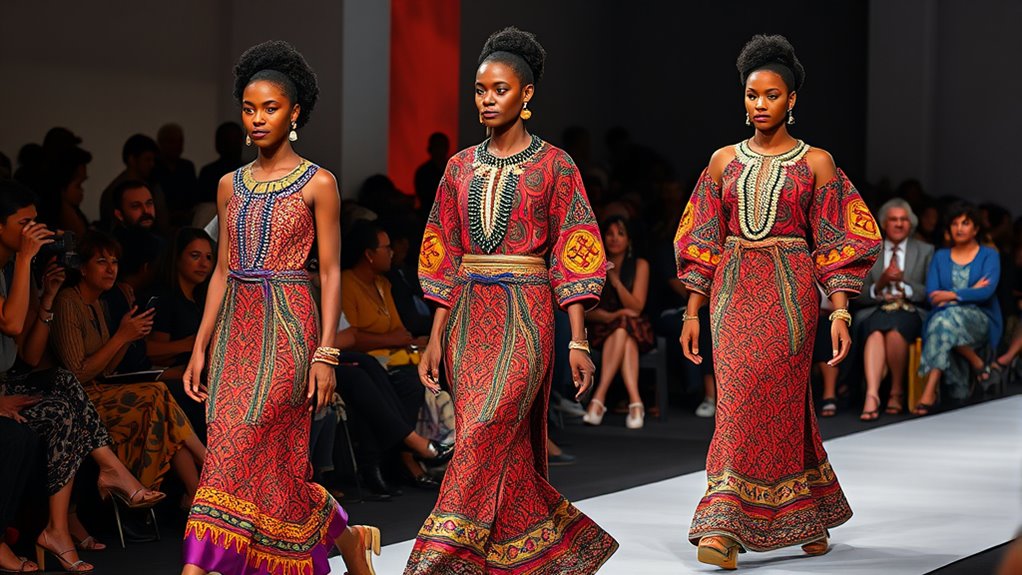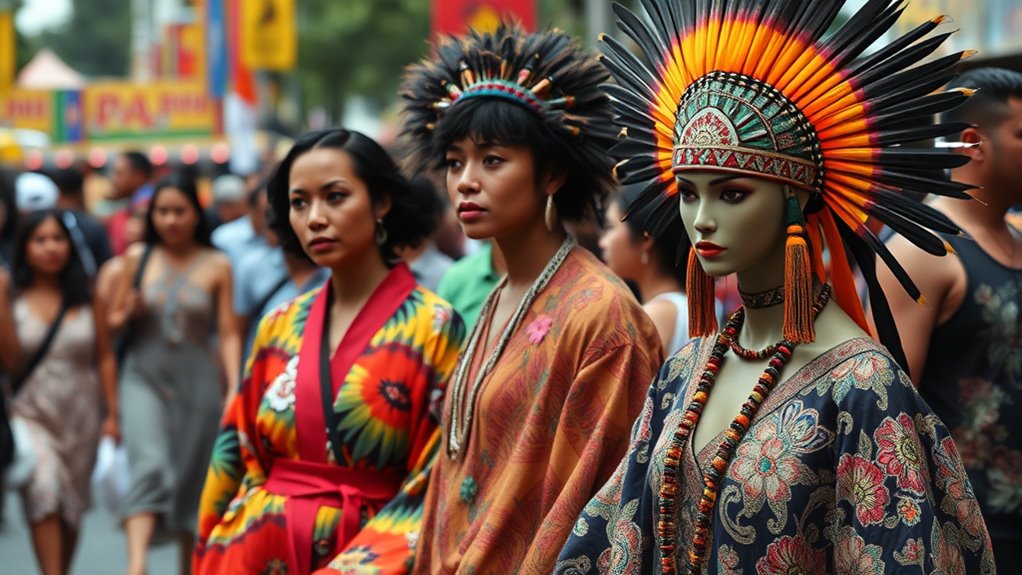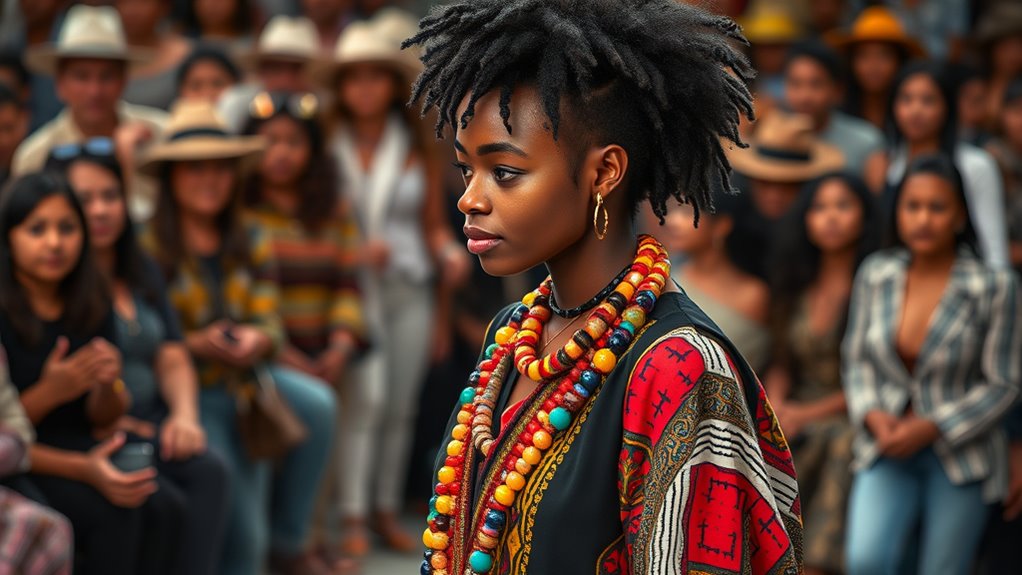Understanding the difference between cultural appropriation and appreciation is key in fashion. Appreciation involves valuing and respecting another culture’s symbols and traditions, often through informed choices or collaborations. Appropriation, however, happens when cultural elements are used without understanding or permission, risking misrepresentation or offense. Recognizing these differences helps you make respectful fashion choices that honor cultural heritage. If you want to learn more about steering through this balance thoughtfully, stay curious.
Key Takeaways
- Cultural appreciation involves respectful learning, collaboration, and understanding of a culture’s symbols, while appropriation often involves superficial or disrespectful adoption.
- Appropriation can strip symbols of their meaning, perpetuate stereotypes, and cause offense, unlike appreciation which honors cultural significance.
- Ethical fashion practices include seeking permission and collaborating with cultural communities, distinguishing genuine respect from exploitation.
- Recognizing the context and significance of cultural symbols prevents misrepresentation and promotes authentic, respectful inspiration.
- Promoting cultural sensitivity involves education, acknowledgment, and celebrating diversity without disrespecting or commodifying cultural heritage.
Defining Cultural Appreciation and Appropriation in Fashion

Understanding the difference between cultural appreciation and cultural appropriation in fashion is essential because it helps you recognize respectful admiration versus harmful misuse. Cultural appreciation involves genuinely valuing and honoring another culture’s traditions, symbols, or styles without taking them out of context or exploiting their significance. It’s about learning, understanding, and celebrating, often through collaborations or informed choices. In contrast, cultural appropriation occurs when you adopt elements of another culture without understanding or respecting their meaning, often for fashion, profit, or trendiness. It can strip cultural symbols of their significance, perpetuate stereotypes, or cause offense. Recognizing these distinctions helps you make more mindful, respectful fashion choices, ensuring you’re honoring cultures rather than appropriating them. Additionally, being aware of cultural symbolism can guide you in avoiding misrepresentation or disrespectful usage of meaningful traditions, especially considering how cultural artifacts are often commercialized or misused in fashion trends. Being sensitive to cultural context is crucial for maintaining respect and avoiding harmful stereotypes.
Recognizing Key Examples and Case Studies

Recognizing key examples and case studies helps clarify how cultural appreciation differs from appropriation in real-world fashion scenarios. For instance, consider when designers incorporate traditional patterns with respect and collaborate directly with cultural communities. An example is the work of Duro Olowu, who combines African textiles thoughtfully, honoring their origins. Conversely, when brands use cultural symbols without understanding or permission, such as a sports team adopting sacred Native American headdresses, it crosses into appropriation. These cases highlight the importance of context, intent, and collaboration. By examining these examples, you can better differentiate respectful acknowledgment from exploitative use. Recognizing these patterns helps you evaluate fashion choices critically, understanding the fine line between celebrating cultures and appropriating them. Additionally, understanding the concept of cultural sensitivity can aid in distinguishing respectful appreciation from harmful appropriation. Developing an awareness of cultural context is essential to ensure respectful engagement with diverse traditions and symbols, especially considering how cultural intelligence plays a role in navigating these complex interactions. Moreover, fostering educational awareness about cultural histories enhances the ability to appreciate cultures authentically and avoid misrepresentation. Incorporating personality traits such as openness and empathy can further promote respectful cultural exchanges in fashion.
Ethical Considerations and Cultural Sensitivity

When engaging with cultural elements in fashion, ethical considerations and cultural sensitivity are essential to prevent harm and promote respectful representation. You should always ask yourself whether you’re honoring the culture or exploiting it. Respect its origins, meaning, and significance before incorporating it into your designs. You can foster a more authentic understanding by exploring the cultural context behind certain symbols or practices. Avoid stereotypes or misrepresentations that could offend or diminish the culture’s value. Be aware of the sensitivities surrounding certain symbols or practices, and seek permission if possible. Collaborate with members of the community to ensure authenticity and respect. Developing emotional intelligence can help you better understand and navigate cultural nuances and sensitivities. Recognizing cultural significance is crucial to ensure that your actions are respectful rather than appropriative. Additionally, understanding the global economic outlook can influence how you approach cultural representation in a way that respects both local and international perspectives.
The Impact on Communities and Cultural Significance

Cultural elements in fashion can deeply impact the communities they originate from, shaping perceptions and reinforcing or challenging stereotypes. When you appropriate cultural symbols without understanding their significance, you risk commodifying or misrepresenting that culture. This can lead to feelings of disrespect, alienation, and erasure within the community. On the other hand, genuine appreciation can elevate cultural visibility and foster understanding. However, even well-intentioned use can cause harm if it strips away its original context or reduces it to a trend. You should recognize that these cultural elements carry deep meaning and history. Respectful engagement involves listening to community voices and understanding their significance before incorporating cultural symbols into fashion. This approach helps preserve cultural identity and promotes mutual respect. Additionally, understanding the cultural significance behind these elements can guide more respectful and meaningful use. Incorporating cultural awareness through education can further prevent unintentional missteps and promote authenticity. Recognizing the importance of cultural sensitivity when engaging with diverse traditions can help foster genuine respect and positive cultural exchange. Moreover, practicing mindful engagement ensures that the use of cultural symbols aligns with the values and wishes of the originating communities. Developing sound design techniques to thoughtfully integrate these elements can enhance respectful representations while avoiding superficial trends.
Navigating Respectful and Authentic Inspiration

Finding respectful and authentic inspiration in fashion requires a thoughtful approach that honors the origins of cultural elements. You should research the history and significance behind the designs, ensuring you understand their cultural context. When drawing inspiration, collaborate with community members or artisans, giving credit and support to their craft. Avoid stereotypical or exaggerated representations that can diminish authenticity. Instead, aim for designs that celebrate cultural diversity genuinely. Remember, your goal is to appreciate without appropriating, so stay aware of power dynamics and avoid commodifying cultural symbols. Engaging with cultural traditions and understanding their meaning can help foster respectful appreciation. Incorporating cultural significance into your designs can deepen authenticity and show genuine respect for the culture. Additionally, understanding cultural symbolism can provide deeper insight into the meanings behind specific patterns or motifs, emphasizing the importance of cultural heritage in crafting meaningful fashion. Being mindful of cultural appropriation helps ensure that your inspiration remains respectful and authentic.
Frequently Asked Questions
How Can Brands Ensure Ongoing Cultural Sensitivity Beyond One-Time Collections?
You can guarantee ongoing cultural sensitivity by continuously engaging with diverse communities and listening to their perspectives. Avoid tokenism by building genuine relationships and involving cultural representatives in your design process. Educate your team about cultural histories and significance. Regularly review your collections for cultural accuracy and respect. By making cultural awareness an ongoing priority, you foster authentic appreciation rather than fleeting trends, creating respectful, inclusive fashion that honors diverse backgrounds.
What Legal Protections Exist Against Cultural Misappropriation in Fashion?
You might think laws protect cultures from fashion missteps, but reality’s different. Laws against cultural misappropriation are nearly nonexistent or vague, leaving designers to navigate ethical gray areas. While copyright and trademark laws cover designs and symbols, they rarely prevent cultural insensitivity. So, your best bet is to stay educated and respectful, because relying solely on legal protections won’t keep your brand from unintentionally offending or appropriating.
How Do Different Cultures Define Respect Versus Disrespect in Fashion?
When exploring how cultures define respect versus disrespect in fashion, you’ll find that respect involves understanding and honoring cultural symbols and traditions. Disrespect occurs when you use cultural elements without acknowledging their significance or exploit them for profit. To show respect, you should educate yourself about the culture’s history and seek permission when appropriate. Engaging thoughtfully demonstrates that you value the culture rather than diminish it through insensitive use.
Can Cultural Exchange Be Sustainable Without Exploitation?
Imagine a garden where each flower blooms in harmony, sharing its unique scent without overwhelming others. When you approach cultural exchange, you can nurture mutual respect by learning and honoring origins without taking more than you give. By listening carefully and giving credit where it’s due, you create a sustainable dance—one where cultures flourish side by side, free from exploitation, like a well-tended garden thriving in balance.
What Role Do Consumers Play in Promoting Respectful Fashion Practices?
You play a vital role in promoting respectful fashion practices by staying informed and mindful of your choices. When you support brands that prioritize ethical sourcing and honor cultural origins, you help foster respect and sustainability. Avoid impulsively purchasing items that seem culturally insensitive. Instead, research and choose products that celebrate cultural diversity responsibly. Your conscious shopping habits can influence the industry to embrace appreciation over exploitation.
Conclusion
As you navigate fashion’s vibrant tapestry, remember that respecting cultures isn’t just a modern trend—it’s like honoring the Mona Lisa’s history in the Louvre. When you draw inspiration, think of it as an authentic mixtape, blending influences thoughtfully without turning into a cultural “mash-up” that disrespects origins. By staying sensitive and respectful, you help preserve cultural identities while still celebrating diversity. After all, fashion is about expression, not exploitation—so wear your respect like a timeless vintage piece.










